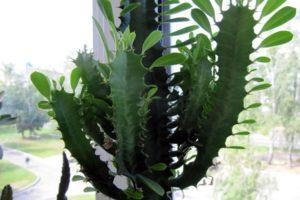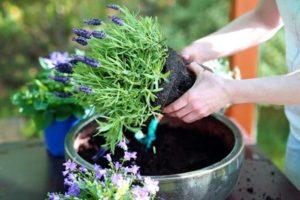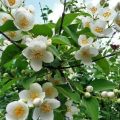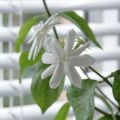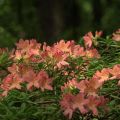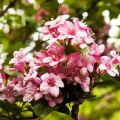The difference between garden jasmine and chubushnik, pruning and care
When jasmine blooms, the air in the gardens is filled with a delicate, magical scent. Large white flowers completely cover the shrub and are the main decoration of the infield.
Garden jasmine bushes are found on the streets of large cities, in parks and squares, orchards and vegetable gardens. Gardeners and florists have long been using beautiful, fragrant bushes to decorate their backyard plots and vegetable gardens.
Interesting! Not everyone knows that garden jasmine, growing in the temperate climate of the middle zone, has nothing to do with real jasmine and is classified as a completely different plant..
But what is the difference, let's figure it out further.
Chubushniki and jasmine: what is the difference?
The shrubs that grow in gardens and parks are different from real jasmine and are called chubushnik. The plant belongs to the hydrangea family.
The natural habitat of this flower is the hot climate of the Caucasian mountain range. But the famous French scientist breeder, acclimatized the thermophilic bush for planting throughout the European part of our continent. The cultivated mock-orange is known to flower growers and gardeners as garden jasmine.
Real jasmine is a tropical shrub that grows in Asia, South America, Africa and Australia. The plant blooms in large flowers with a pungent and heavy aroma. Real jasmine belongs to the plants of the olive family. In temperate and continental climates, it is almost impossible to grow a shrub.
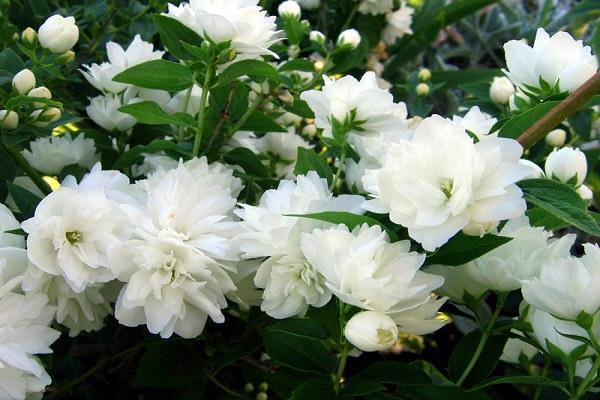
Types of chubushnik
Chubushnik is divided into many types, and they all have high decorative qualities.
Odorless
Tall shrub with a voluminous crown, more than 3 m in diameter. Leaves are small, bright green shades. Blooms in large, odorless white flowers. The active flowering phase occurs in mid-summer. Florists and landscape designers use the plant for living fences and garden compositions.
Small-leaved
The maximum height of the bush is 1.5 meters. The crown is lush, spreading with small, delicate leaves. The plant blooms in early summer with white clusters of inflorescences. The delicate scent of flowers combines hints of pineapple and strawberry.
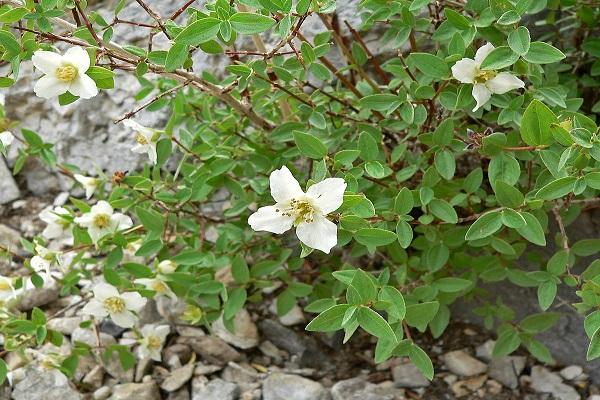
Schrenck
This type of mock-orange in its natural environment is listed in the Red Book. Bushes of the plant are tall, from 2 to 3 m, with dense foliage and shoots covered with fluff. The cluster-like inflorescences bloom in large, white flowers with a delicate aroma.The flowering period is long.
Coronary
The bushes of the crown mock-orange grow no more than 3 m. The leaves of the shrub are large, with small denticles, the outer side of the leaf cover is bright green shades, the inner side is paler.
Large cluster-like inflorescences bloom in large, white flowers with a cream shade. The aroma of a flowering bush is most similar to jasmine, but more subtle and delicate.
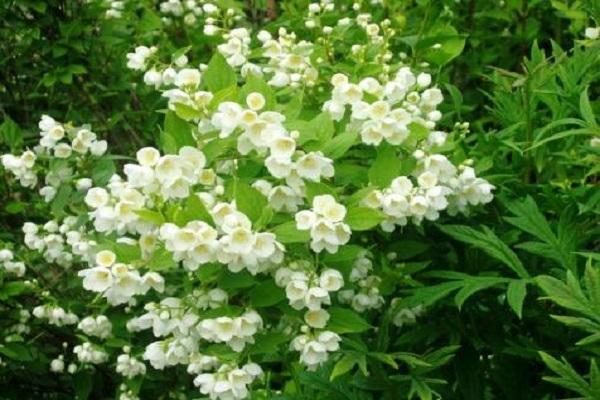
The main varieties of jasmine
To date, several types of garden jasmine have been bred by breeders. The main differences lie in the decorative qualities of the plant, the size and duration of flowering.
Small-leaved
A compact plant up to 1 m high with curved leaves and large inflorescences. During the flowering period, white flowers bloom with a delicate strawberry aroma.
Ordinary
Tall, sprawling shrub grows up to 3 m. Completely covered with small leaves of rich green color with a golden tint. During the flowering period, large, cluster-shaped inflorescences appear, which bloom in large white flowers with a sweetish aroma.
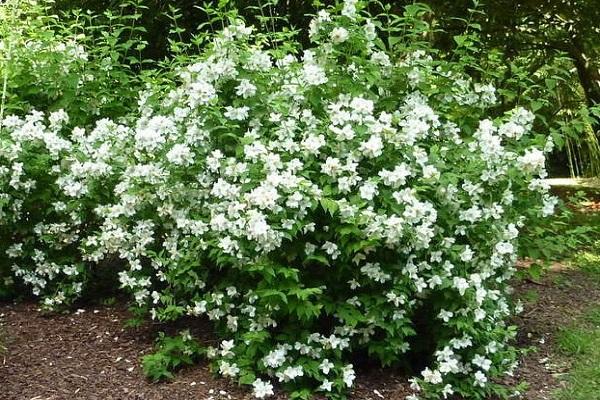
Fluffy
The largest representative of garden jasmine. The bushes grow up to 4 m, densely covered with green leaf plates. Inflorescences are large, cluster-shaped, bloom in large, odorless white flowers. The shrub enters the long flowering phase in the second half of summer.
Can I plant next to
Garden jasmine is a cultivated plant that was derived from various varieties of chubushnik. Therefore, joint planting of these plant species is quite acceptable.
Important! Garden jasmine is not only a beautiful but also a useful plant. During the flowering period, essential oils are formed in the inflorescences, which contain many useful substances necessary for the life of the body.
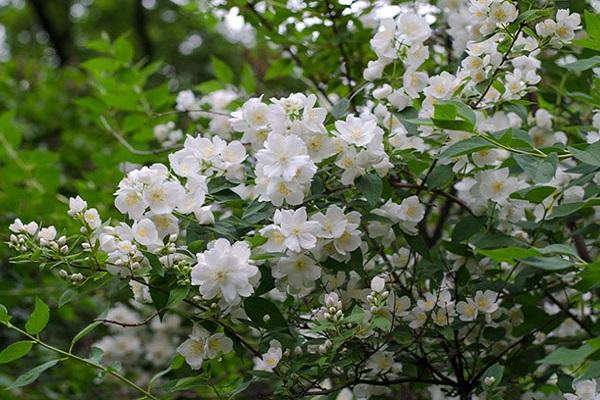
Advantages and disadvantages of joint disembarkation
Flowering shrubs have excellent decorative properties. Plants planted together, with proper care, form beautiful bushes, from which a decorative living fence of a personal plot is created.
Shrubs develop rapidly, and after 3-4 years they reach maturity. The only drawback of plants is considered their increased sensitivity to unmoistened soils and droughts.
What shrubs are sick with
Garden jasmine and chubushnik rarely get sick and are exposed to pests. But because of the dense planting, it is necessary to become infected with one bush, the diseases immediately spread to neighboring plants. Therefore, in autumn and spring, shrubs are treated with professional preparations.

Diseases and pests:
- If grayish spots appear on the leaves, this means that the shrub is exposed to gray rot.
- Drying of the leaf cover causes aphids, which suck the cc from the plants.
- If white butterflies have appeared on the bushes, then it is more likely a hawthorn. In winter, its caterpillars will damage the buds, and in spring, young shoots.
- Shrub rhizomes often suffer from click beetle larvae, which completely destroy them. Meanwhile, adult beetles eat the leaf cover of shrubs.
Important! Garden jasmine loves abundant watering, but the close location of groundwater causes rotting of rhizomes and the spread of fungal diseases.
Pollination
If the same varieties of culture are planted, then they are not afraid of cross-pollination. It is necessary to avoid planting hybrid, terry shrubs, which, when pollinated, lose their decorative properties.
Such plants are planted separately, away from the main plantings.
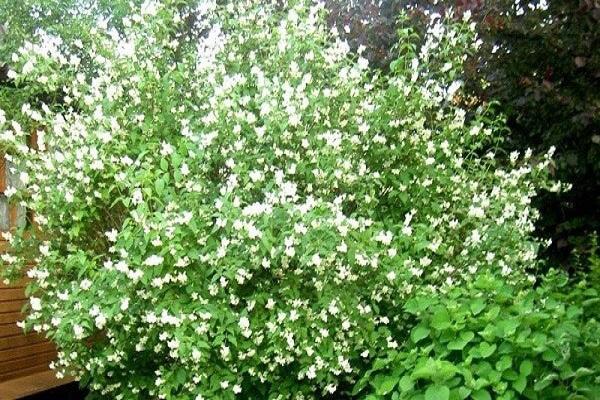
How to care for crops
Garden jasmine is a long-liver. With proper care, the bushes retain their decorative effect from 20 to 30 years.Shrubs do not require increased attention to themselves, but compliance with the rules of agricultural technology is a prerequisite for the proper growth and development of these garden beauties.
Sunshine areas protected from drafts are a suitable place to plant this crop.
Garden jasmine and chubushnik are unpretentious to the composition of the soil. Shrubs are planted in open ground in spring or autumn.

Watering
Garden jasmine is a moisture-loving plant, therefore, the irrigation regime is observed throughout the growing season. Irrigation works are carried out once every 7-9 days. Under each bush spill from 20 to 30 liters of settled water.
During periods of prolonged heat and drought, the plant is watered additionally.
Fertilization
They begin to feed and fertilize the shrub from 3 years of growth. In mid-spring, the plant is fertilized with organic matter or mineral fertilizers. In late May, early June, the procedure is repeated. After the shrub blooms, it is fed with phosphate or potassium fertilizers.
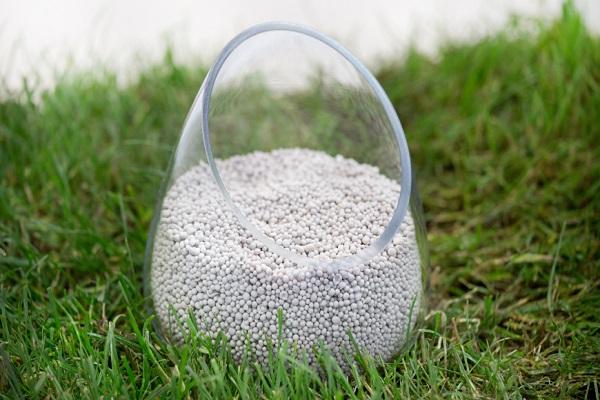
Features of the formation of a bush in jasmine and mock orange
In order for the shrubs to look lush and beautiful, formative pruning is carried out annually. The procedure is carried out immediately after the flowering of the plant.
- All dried inflorescences are removed.
- In thickened plants, 20 to 25% of the cuttings are cut off at the base.
- New shoots are cut to the stiff base of the branches.
- The longest shoots are cut off from tall bushes.
Important! Sanitary pruning of plants is carried out in autumn and spring. Weak, broken and frostbitten bush branches are cut.
Wintering plants
Mature plants are more resistant to frost and temperature extremes than young growth.
- Garden jasmine at the base is insulated with straw or dry foliage.
- If a cold winter is expected, then the bush is covered with special materials.
- In the fall, the soil under the bushes is carefully dug up and mixed with compost.
Garden jasmine and chubushnik are not susceptible to freezing in temperate climates. But in the northern regions, shrubs require additional insulation for the winter.
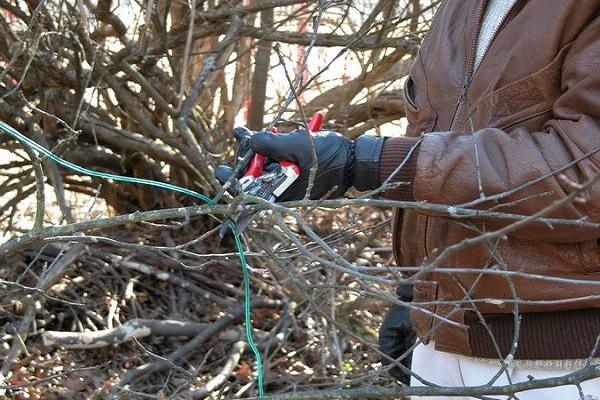
Reproduction
You can increase the number of garden jasmine on your own. To do this, you need to choose one of the plant propagation methods.
- The seeds are planted in open ground in the fall, deepening by 25-30 cm. The plot with the planted seeds is mulched. In the spring, the mulch is removed.
- Reproduction by cuttings is carried out in the spring, or after the end of flowering. The upper shoots are cut from the mother bush, which are planted in open ground and covered with a film or glass jar. Once the cuttings are rooted, they are opened and transplanted to their permanent planting site.
Outcome
Based on the foregoing, we can conclude that both chubushnik and garden jasmine are unpretentious plants, but with high decorative qualities. On home gardens, flowering shrubs will become the main decoration and delight with their delicate aroma.
